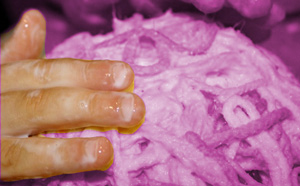Purple for the Common People Too
It is commonly taught that the purple dye Lydia used for her business was expensive because it was the product of crushing the murex seashell, and thus, was reserved for the wealthy. HOWEVER, substantial modern archaeological evidence, backed by modern scientific methods, have challenged the often quoted "expensive purple dye made from seashells" description of Lydia's business in favor of more varied sources of purple, including from the "madder" root, and for the use of purple in a wide array of clothing for people of all social stratas. See the scholarly citation below.
It should be noted that the madder root produces a more "reddish" purple depending on the dying process. These "madder root" shades are widely found in textiles in Middle East to this day.

How to dye your own wool with madder root.
Drawing with purple yarn on sticky paper
Easy to weave yarn hospitality coasters using a paper plate as the loom

Making Purple Yarn "Hospitality" objects (yarn dipped in glue and
shaped over an object that is removed when glue is dry. How to.)
Excerpts from a scholarly article by Professor David Graves (Ph.D Univ of Aberdeen, Biblical Archaeology)
IN CONCLUSION
(via the archaeological findings) It becomes clear that various textiles were dyed using different methods and combination of dyes depending on the color, quality and value. More expensive dyes, such as Tyrian purple, allowed for more expensive clothes, while more economical dyes provided for less expensive textiles. The diverse purple dyed product line, formulated from the various shades of purple, provided a wide range of textiles from various prices to meet the demand in the local and general economy.
Therefore.... It seems likely that Lydia was a wealthy woman who learned her trade in Thyatira and moved to Philippi to carry on her business. She not only dealt in purple textiles, made from madder root, but also from the murex shellfish, since there was a demand from many in Roman society for a diverse quality purple cloth that was also available inland.
Given the everyday use of togas and tunics, with purple clevi in Roman society, along with the more specialty groups, such as the Jewish and military community in Philippi that used purple garments, Lydia would have had a market for a wide price range of products to offer her customers. There seems little doubt that she would have either employed or purchased textiles, dyed from both madder, as well as murex, to meet the demand of her clients.






